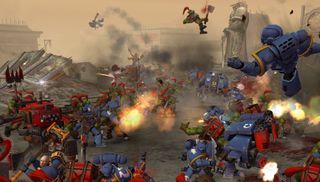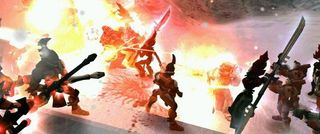Dawn of War retrospective: ten years of war in the 41st millennium

The Wraithlord is a twelve-foot tall monster crafted from psychic bone, imbued with the spirit of an ancient warrior who exists to only to kill. The Space Marine Captain is the champion of a barely-human warrior caste who runs around in power armour that compounds his ridiculous strength. When these two meet on a battlefield, something messy and exciting ought to happen.
In Dawn of War, it does. The Wraithlord burns the Captain with his fist-mounted flamethrowers and then crushes him with the squeeze of a single hand. The Captain pops in a cloud of red goo that Relic refer to as the "blood pinata" effect, and the Wraithlord throws his broken corpse out of the melee leaving a messy trail across the map. It's grim. It's perfect. Dawn of War is one of the few games to get close to delivering the spectacle the Warhammer 40k universe demands. In pursuit of that fantasy, Relic also challenged the RTS format created by Dune 2 and proliferated by Command & Conquer, StarCraft and Age of Empires.
"One of the expressions on the team at the time, as was related to me, was 'in the 41st millennium, no-one chops wood.'" says Phillip Boulle, campaign and narrative designer on Dawn of War and its subsequent expansions. "It was all about going out, all the ways you got resources were points of conflict. Go out, fight with the enemy early."

Dawn of War does this by inverting the traditional RTS map, which tucks static resources into safe corners behind each faction's base. Dawn of War ties resources to capture points in the battlefield, a move inspired by the original Warhammer ruleset. "In the tabletop game, there isn't really any resourcing," says Ian Cumming, artist, modeller and art director on Dawn of War and Dark Crusade. "It was all about combat and the variety that comes from that, from the different races. Putting the resource system in the field with the control points really served that."
It also granted Dawn of War's battles a refreshing sense of immediacy. At the time the RTS relied heavily on the hypnotic rhythm of mining and building. The base-stomping final third of an encounter served more as a congratulatory firework display than an expression of combat. Dawn of War is about aggression. From the opening seconds of a fight you're taking, holding and repelling. The Warhammer fantasy demanded a game about conquest, not administration.
This aggressive intent even surfaces during base-building. When the Space Marines order a new building, it crashes in from orbit and unfolds into a factory. "Most other games previously had put all of the pizazz at when you finish building something. The problem there of course is when you finish building, you're not looking at it," says Boulle. Even small touches like this reinforce the idea that the player should be busy waging war. Only war.

Base buildings were one of a few areas that Relic were allowed to toy with in an otherwise meticulously documented universe. Building Dawn of War also meant building a relationship with Games Workshop, Warhammer's famously protective custodians. "Working with any intellectual property has constraints," says Boulle, "but it's those constraints that make something great. If we could do whatever we wanted, we wouldn't be doing a 40k game, we'd be doing some sort of watered down version."
The biggest gaming news, reviews and hardware deals
Keep up to date with the most important stories and the best deals, as picked by the PC Gamer team.
Relic were free to fill in the blanks that exist in the tabletop game, and impressed with their realisation of bases, environments and weapon effects. "One anecdote when I came on the team was the Games Workshop guys telling me that when they first saw the Eldar Eldritch Storm—the ultimate Eldar ability that had been in the tabletop for ten years at that point. When they first saw our realisation of it they were like “YES, that's what we've been describing for ten years but we've never been able to show it. This is it ." That was a big moment for us."
Relic designed units that, in the case of the Eldar Bonesinger, went on to become models in the tabletop game. They built their own Space Marine chapter, The Blood Ravens, which found its way into White Dwarf, Games Workshop's rulebooks and three novels devoted to the chapter. "They let us build something that others hadn't been allowed to build before. That's because we were able to show that we got it," says Boulle.

They did. That moment, when a Wraithlord faces off against a Space Marine Captain in a throng of embattled minions, shows that they got it. Dawn of War's decade-old, low-poly models still demonstrate a good understanding of the joyful, splattery absurdity of the universe. The Space Marine orbital strikes still feel utterly devastating, and the faction rosters fearlessly incorporate some of Warhammer's most extreme units. There's something right about a studio that looks at the Exorcist tank , an artillery vehicle that fires barrages from a pipe organ, and says "that's going in our videogame."
It's still a good, challenging RTS. If you're tempted to try it, I'd recommend starting with Dark Crusade expansion for its standout singleplayer campaign that lets you play as one of seven factions in a royal rumble for control of a planet. It's the best realisation of the 40k 'everyone hates everyone' idea, and has some of the neat wargear progression that Relic invested in heavily for Dawn of War 2. PCGamingWiki suggest some good tweaks that unlocks the camera zoom and improves the visuals a bit.
But what for the future of the series? "We're super thrilled with the reaction we've gotten," says Boulle. "We're focused on Company of Heroes: Ardennes Assault, which we just announced. Yeah, Dawn of War remains an important property for us and we continue to look for ways to invest in it."
To celebrate the ten year anniversary of Dawn of War, we're giving away 5,000 copies of the game, complete with expansions. Relic are also running some competitions around the anniversary which you can follow on the Dawn of War twitter account and the Dawn of War site .
Part of the UK team, Tom was with PC Gamer at the very beginning of the website's launch—first as a news writer, and then as online editor until his departure in 2020. His specialties are strategy games, action RPGs, hack ‘n slash games, digital card games… basically anything that he can fit on a hard drive. His final boss form is Deckard Cain.

If you love big trucks, establishing trade routes, and the phrase 'post-apocalyptic survival business simulator' then I've got just the strategy RPG for you

Blizzard veteran David Kim's strategy comeback with Battle Aces is 'very personal:' 'I just can't accept... the end-all peak of RTS is StarCraft 2 and nothing can ever be better'
Most Popular

